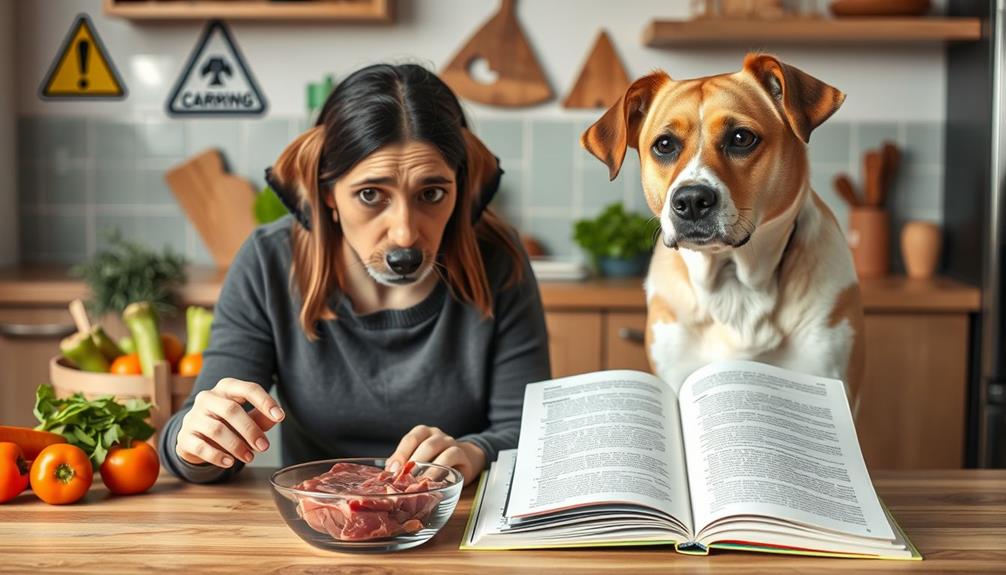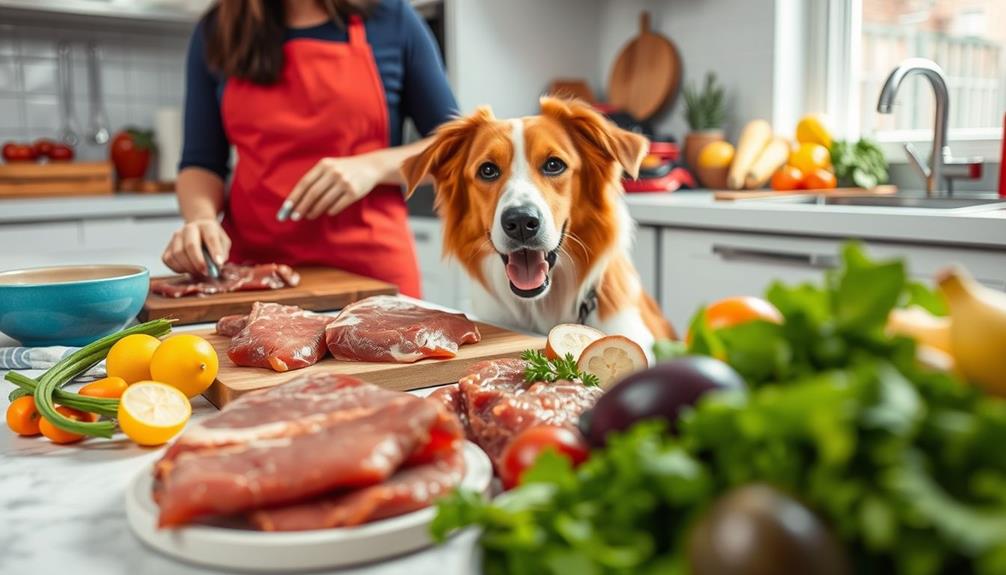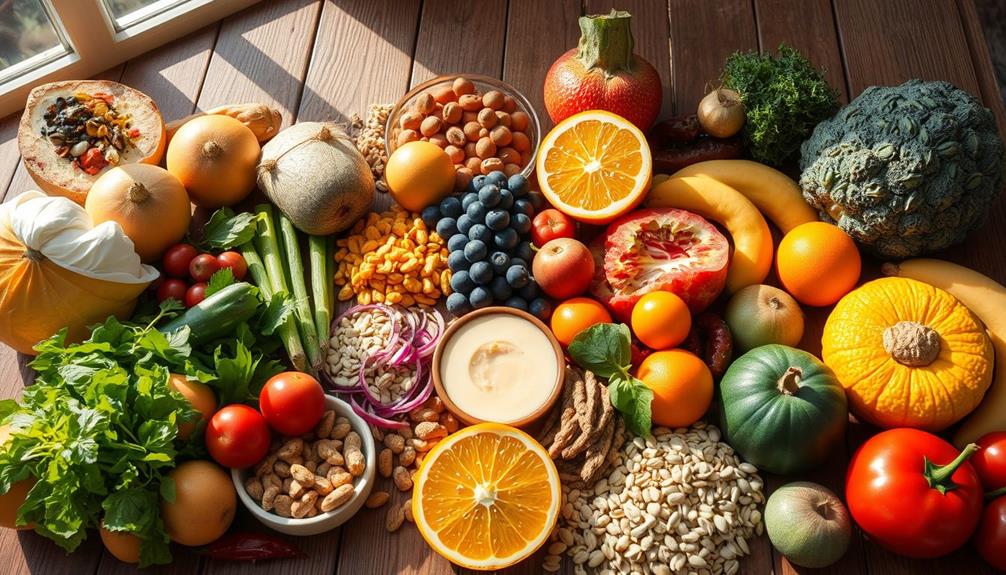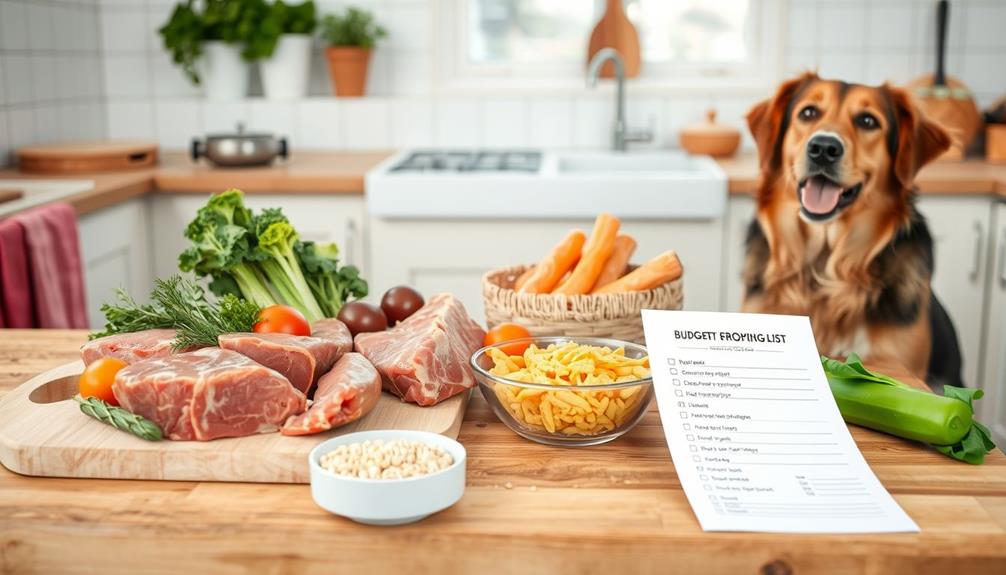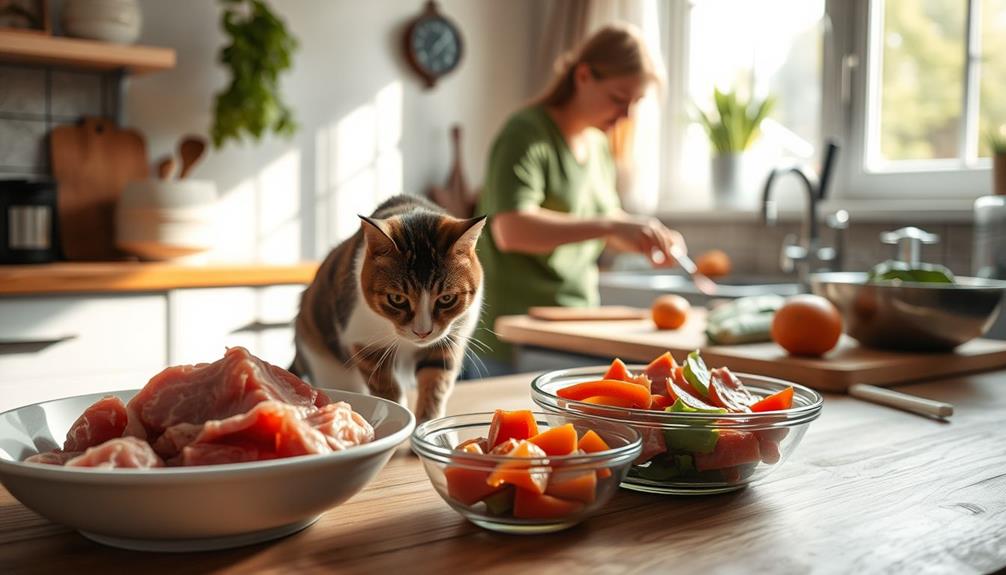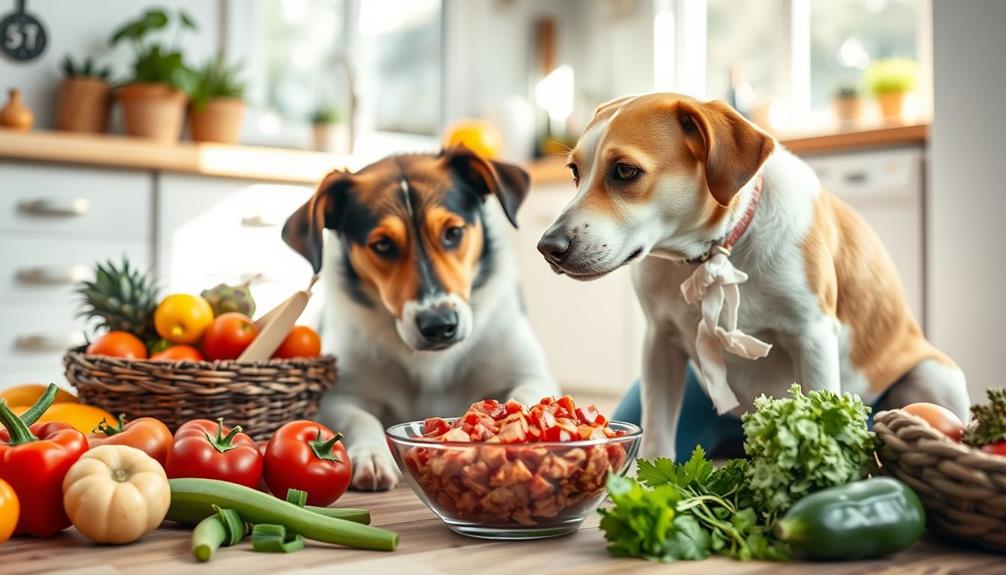Yes, raw food can definitely make your dog sick. It exposes them to harmful bacteria like Salmonella and Listeria, which can cause serious gastrointestinal issues, including fever and vomiting. About 25% of raw food samples test positive for these pathogens. Additionally, raw diets might lack essential nutrients, leading to imbalances that could harm your dog's health. Proper handling is vital to minimize contamination risks, both for your pet and your family. If you want to guarantee your dog stays healthy on a raw diet, there's more you should know about safe practices and nutritional needs. Can raw food harm dogs? Yes, it can. In addition to the potential for harmful bacteria and nutrient deficiencies, raw diets can also present a choking hazard, especially for puppies and small breeds. The bones in raw meat can splinter and cause gastrointestinal blockages or injuries. It’s important to carefully consider the risks before deciding to feed your dog a raw diet and consult with a veterinarian to ensure that they are getting the necessary nutrients in their meals.
Key Takeaways
- Raw diets can expose dogs to harmful bacteria like Salmonella and Listeria, which can lead to serious health issues.
- Approximately 25% of raw food samples test positive for pathogens, posing a risk to both pets and humans.
- Nutritional deficiencies may occur in raw diets, lacking essential nutrients like taurine and vitamins.
- Safe handling practices are crucial to prevent contamination, including thorough handwashing and disinfecting surfaces.
- Pet food recalls often stem from contamination, highlighting the need for vigilance in checking for safety alerts.
Risks of Raw Diets
When considering a raw diet for your dog, it's important to understand the potential risks involved. Feeding raw diets can expose your pet to harmful bacteria like Salmonella and Listeria, which pose significant health risks. Nearly 25% of raw food samples tested positive for these pathogens. Salmonella can cause severe gastrointestinal symptoms in both dogs and humans, and an estimated 1.2 million cases of salmonellosis occur annually in the US.
Additionally, it's necessary to be aware of common types of cold medications that may also pose risks if your dog is exposed to them inadvertently.
Listeria, on the other hand, can lead to listeriosis, with over 90% of cases resulting in hospitalization. This is particularly concerning for vulnerable populations. Dogs can carry these bacteria without showing any symptoms, increasing the risk of transmission to you and your family, especially if anyone is immunocompromised.
Additionally, raw diets often lack nutritional balance, leading to potential deficiencies that can adversely affect your dog's health. That's why consulting a veterinary nutritionist before making any dietary changes is important.
Ensuring food safety is crucial for your pet's health, and understanding these risks can help you make informed choices when it comes to their diet.
Health Impacts of Pathogens
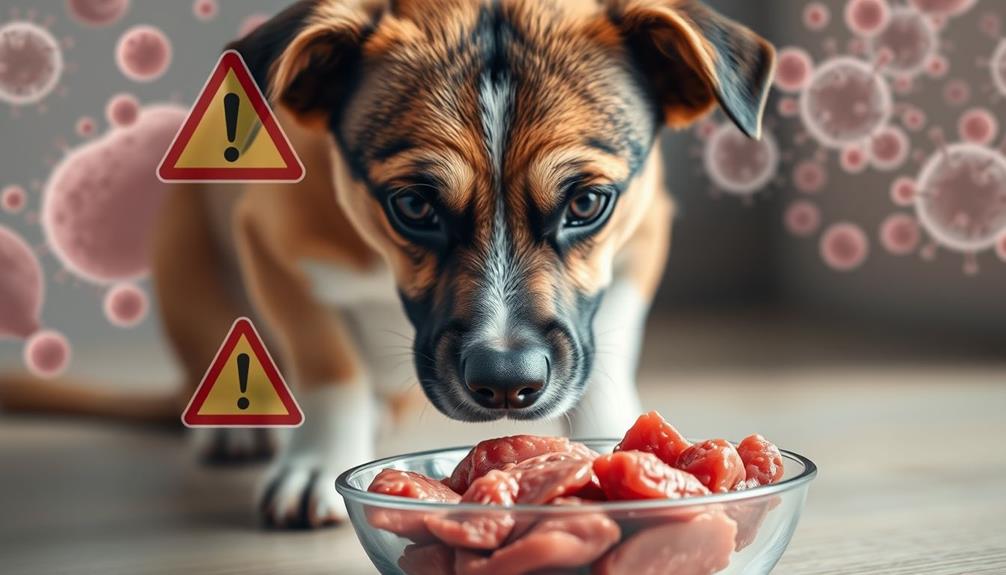
Pathogens lurking in raw dog food can seriously impact your pet's health and your family's well-being. Many pet owners are unaware that nearly 25% of raw food samples tested positive for harmful bacteria like Salmonella and Listeria. These bacteria pose significant health risks to both dogs and humans.
For instance, Salmonella infections can lead to severe symptoms in dogs, including fever, diarrhea, and vomiting. Alarmingly, over 1.2 million cases of salmonellosis occur annually in the U.S. among humans, often linked to food-borne illness. Additionally, ensuring proper hygiene practices when handling pet food is essential, as even small lapses can result in contamination routine health checks for signs of illness or injury.
Listeria monocytogenes can be especially dangerous, causing severe illness in vulnerable populations. Dogs can carry this bacteria without showing symptoms, increasing the risk of transmission to you and your family.
The CDC and FDA warn that handling raw food raises the likelihood of spreading pathogens through contaminated hands, surfaces, and utensils. This risk is particularly concerning for immunocompromised individuals, who face a greater chance of severe infections from these pathogens.
As a pet owner, it's vital to weigh the health risks associated with feeding raw food against the benefits before making a decision for your furry friend.
Safe Handling Practices
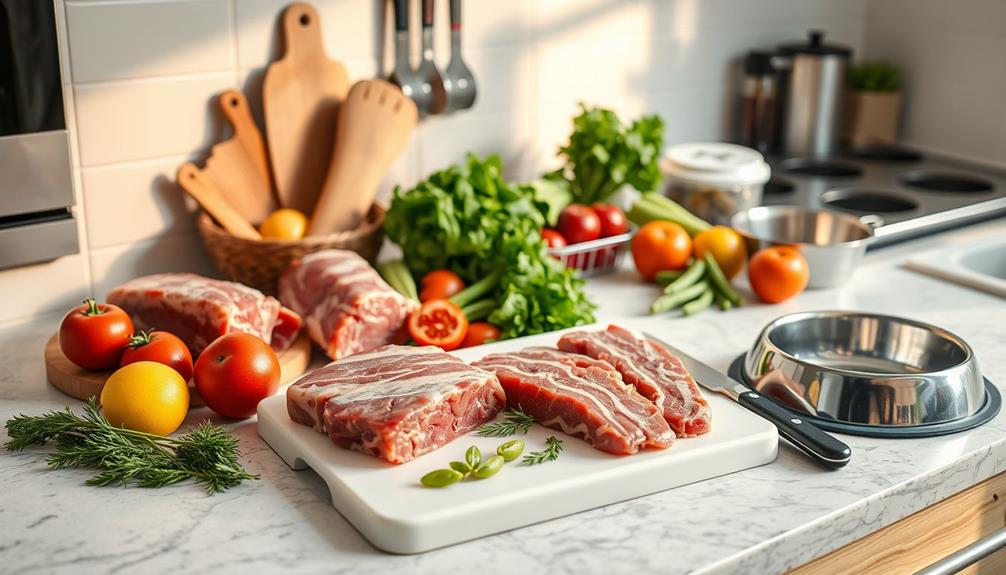
When handling raw dog food, it's essential to wash your hands thoroughly with soap for at least 20 seconds to keep harmful bacteria at bay.
Additionally, ensuring that your pet's eating area is free from contaminants can help maintain a safe environment, similar to the importance of maintaining air purifier maintenance for your home.
You should also clean and disinfect all surfaces and utensils that come into contact with the food.
These safe handling practices are key to protecting both you and your furry friend from potential health risks.
Handwashing Procedures
It's essential to prioritize hygiene after handling raw dog food to protect yourself and your family from harmful bacteria. Start by following proper handwashing procedures. Wash your hands thoroughly with soap and water for at least 20 seconds after handling any raw dog food. This step is important to prevent the spread of harmful bacteria like Salmonella and Listeria.
Additionally, maintaining a clean kitchen environment is necessary, as regular review of your hygiene practices can help identify any areas for improvement.
To further minimize risks, use separate utensils and cutting boards specifically for raw dog food. Always sanitize these items after use to avoid cross-contamination with other food items.
Immediately clean and disinfect surfaces that have come into contact with raw dog food to lower the risk of foodborne illness in your household.
Avoid rinsing raw meat before preparation, as this can cause splash contamination, spreading bacteria around your kitchen.
Additionally, if there's any uneaten raw dog food, refrigerate it promptly or dispose of it safely to prevent bacterial growth and contamination.
Surface Disinfection Techniques
After ensuring your hands and kitchen are clean, focus on effective surface disinfection techniques.
When you handle raw food, it's essential to disinfect all surfaces, utensils, and dishes immediately after use to prevent cross-contact in your kitchen. This helps eliminate potential pathogens like Salmonella and Listeria, which are bacteria that can cause serious health issues.
Always wash surfaces with hot, soapy water and follow up with a disinfectant specifically designed to kill bacteria. For more information on safe food prep areas, check out best practices for organizing prep tables.
Avoid rinsing raw meat before preparation, as this can lead to splash contamination, spreading harmful bacteria onto surrounding surfaces.
If you have any uneaten raw dog food, refrigerate it promptly or dispose of it safely to prevent the risk of foodborne illness.
Nutritional Considerations

A raw food diet for dogs can lead to nutritional deficiencies, particularly in essential nutrients like taurine, which is vital for heart health.
Additionally, certain raw foods may pose risks, such as gastrointestinal issues or exposure to harmful bacteria, making it important to guarantee food safety and proper handling. Without a balanced diet, your dog may face potential health issues that could stem from these deficiencies.
It's important to conduct a thorough nutritional analysis of any homemade raw food diet to identify gaps in nutrients and confirm it meets all dietary requirements. For more information on dietary impacts, consider nutritional analysis for peak health.
Consulting with a board-certified veterinary nutritionist is highly recommended when considering raw food diets. They can help you create a meal plan that achieves nutritional adequacy and addresses any potential deficiencies.
Commercially prepared raw diets might also require additional supplementation of calcium, vitamins, and minerals to provide a complete and balanced diet.
Pet Food Recalls Overview
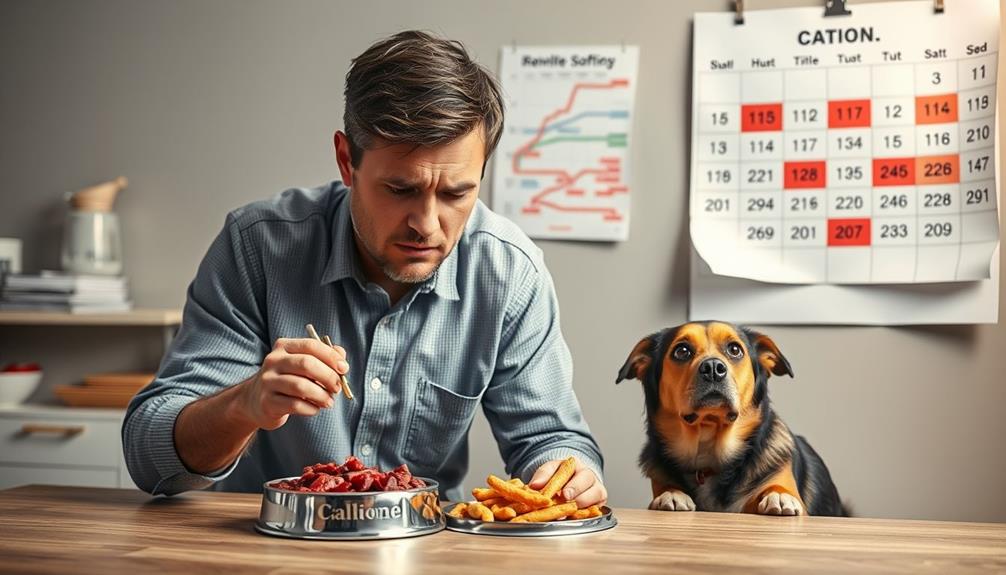
When it comes to pet food recalls, knowing the common reasons behind them can help keep your dog safe.
Factors such as contamination, improper labeling, and ingredient sourcing often lead to these recalls.
Staying informed about recalls is vital, as contaminated food can seriously impact your pet's health.
You should regularly check for updates to guarantee you're protecting your furry friend from potential dangers, including insights on Gold IRA offerings which can help you secure your financial future while caring for your pet.
Common Recall Reasons
Pet owners should be aware of the common reasons behind pet food recalls, as these issues can greatly impact their furry friends' health.
Contamination with harmful bacteria is a leading cause of pet food recalls, particularly in commercially available raw dog food. It's important to take into account that a balanced diet, which includes safe food choices, plays an essential role in maintaining your pet's health, similar to the emphasis on sustainable weight loss for overall health.
Here are three common recall reasons to keep in mind:
- Salmonella Presence: Many recalls stem from positive tests for Salmonella, which can cause severe health risks for both pets and humans.
- Listeria Contamination: This harmful bacterium can also lead to significant recalls, threatening the well-being of your pet and your family.
- Pathogenic Microorganisms: The FDA often identifies recalls based on the presence of various pathogenic microorganisms, highlighting ongoing safety concerns in the pet food industry.
When you receive a recall notification, it's vital to take immediate action.
Check the FDA's Recalls & Withdrawals Web page regularly to stay informed about potential risks associated with your pet's food. By staying vigilant, you can help guarantee the health and safety of your beloved companions.
Staying Informed Regularly
Staying informed about pet food recalls is essential for every dog owner. The FDA maintains a list of recalled pet foods due to potential contamination with harmful bacteria like Salmonella and Listeria.
Regularly checking the FDA's Recalls & Withdrawals webpage helps guarantee your pet isn't consuming unsafe products, especially if you're feeding them raw food. Both raw and cooked pet food can be subject to recalls, so vigilance is imperative regardless of the diet type.
It's important to recognize that just as individuals with certain health conditions, such as Borderline Personality Disorder (BPD), may require specific dietary considerations, dogs may also have unique dietary needs that should be monitored closely.
When you receive a recall notification, it's important to take immediate action to protect your dog's health. Ignoring such alerts could expose your pet to serious health risks.
Awareness of pet food recalls is essential since these events can happen frequently, reflecting ongoing food safety issues in the pet food industry.
Impact on Pet Health
Many dog owners mightn't realize the serious impact that pet food recalls can have on their furry friends' health.
Raw pet foods, while popular, can pose significant health risks due to contamination with harmful bacteria like Salmonella and Listeria monocytogenes. These pathogens can lead to severe foodborne illnesses not just in pets, but also in humans.
It's essential for pet owners to be aware of the mammography guidelines that emphasize the importance of early detection, as similar principles apply to recognizing and responding to health risks in pets.
To help you understand the risks better, here are three key points to keep in mind:
- Recall Awareness: The FDA actively maintains a list of recalled pet foods. Make it a habit to check this list regularly to keep your pet safe.
- Contamination Statistics: Between 2010 and 2012, studies found that 15 samples of raw pet food tested positive for Salmonella, and 32 for Listeria monocytogenes. This highlights the potential dangers of raw food diets.
- Immediate Action: If you receive a recall notice, act quickly to protect your pet's health. Ignoring these alerts can lead to serious health risks for your furry friend.
Stay informed and take precautions to minimize the chances of foodborne illnesses affecting your pet's health.
Trends in Raw Diets
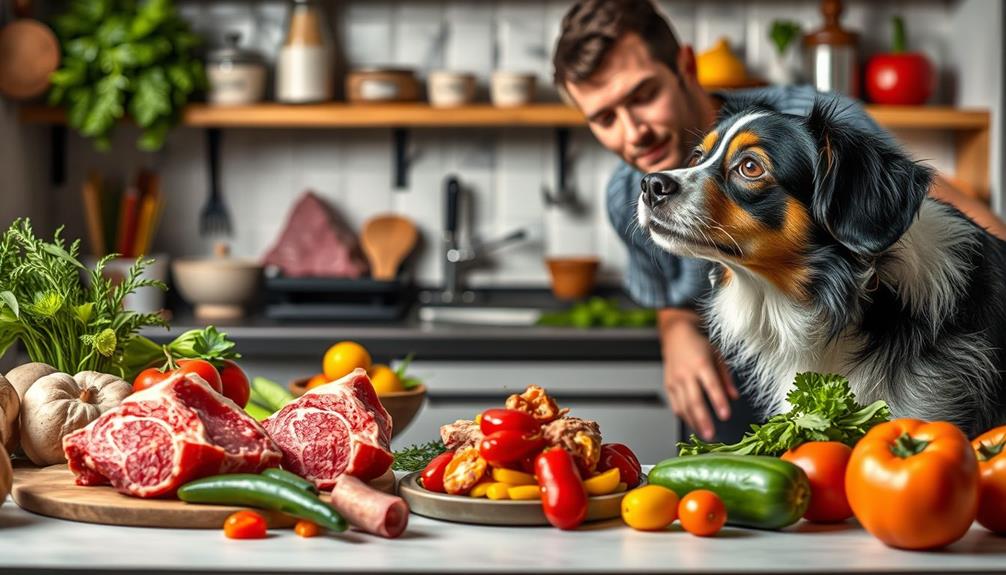
The rise of raw pet food is hard to ignore, with sales increasing by 15% annually as more dog owners embrace this dietary trend. Approximately 15-25% of dogs and 10% of cats are now on some form of raw meat-based diets (RMBDs). While many pet owners believe in the health benefits of raw food, there are important considerations when feeding RMBDs.
| Aspect | Benefits | Risks |
|---|---|---|
| Nutritional Value | Provides natural nutrients | Potential nutritional imbalances |
| Convenience | Easy access to commercial raw | Risks of feeding raw meat |
| Variety | Multiple protein sources | Need for careful preparation |
| Palatability | High appeal for pets | Bacterial contamination |
| Cost | Competitive pricing | Requires dietary knowledge |
Many owners add raw eggs or meat to their pets' diets without consulting veterinarians, risking nutritional imbalances. If you're considering a raw diet for your dog, think about opting for complete and balanced commercial raw options. These diets can minimize the risks of feeding while ensuring your pet receives essential nutrients.
Veterinary Perspectives
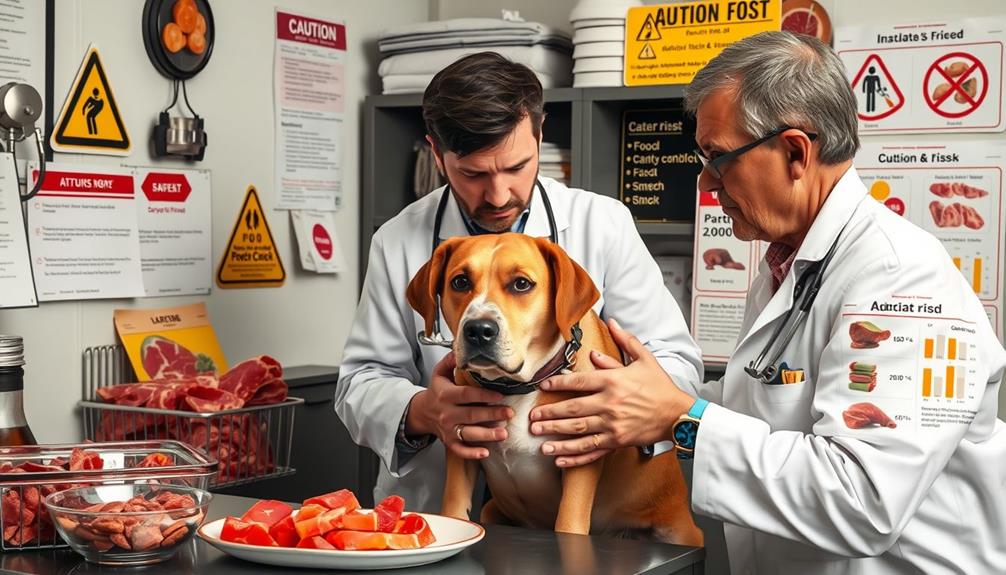
Veterinary professionals often express serious concerns about raw food diets for dogs, highlighting the potential health risks associated with harmful bacteria like Salmonella and Listeria.
The Canadian Veterinary Medical Association (CVMA) warns that the dangers of raw diets often outweigh any perceived health benefits.
Here are three key risks of raw food diets to take into account:
- Pathogen Presence: Studies show that nearly 25% of raw pet food samples test positive for pathogens. This can lead to serious illnesses for both dogs and their owners.
- Nutritional Imbalance: Raw diets can lack balanced nutrition, which is essential for your dog's overall health. Veterinary guidance guarantees your pet receives the necessary nutrients.
- Contamination: Handling raw food poses risks not just to your pet but to your family as well. Safe food handling practices are crucial to minimize these risks.
Regular consultations with your veterinarian are important if you're weighing raw diets.
They can provide tailored advice, monitor for health issues, and help you understand the significance of balanced nutrition for your furry friend.
Prioritizing your pet's health means making informed dietary choices.
Resources for Pet Owners
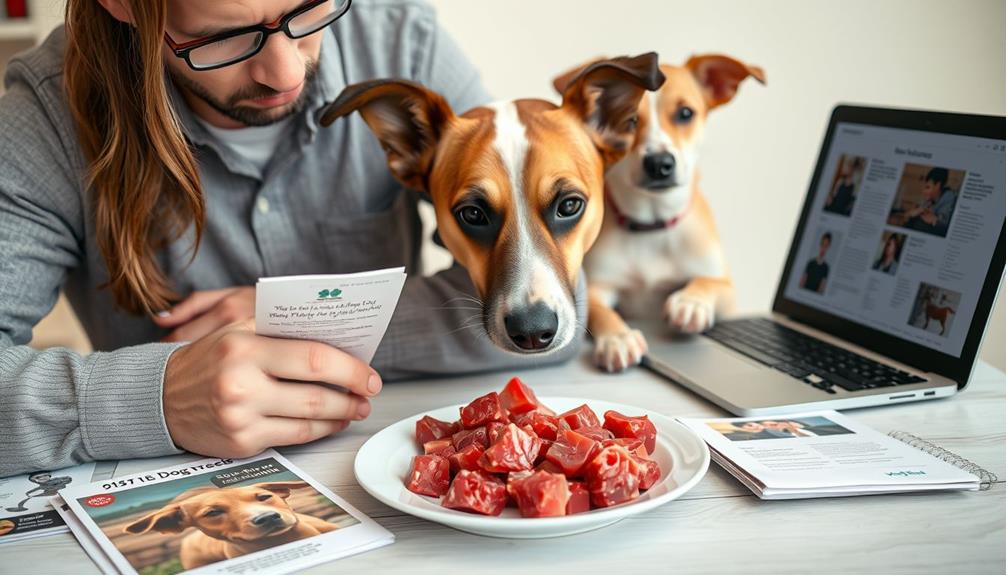
Pet owners looking to make informed decisions about their dog's diet can find valuable resources that address the risks associated with raw food. Organizations like the CDC and FDA provide critical information about the prevalence of harmful bacteria, noting that nearly 25% of raw food samples tested positive for pathogens like Salmonella and Listeria.
These bacteria can pose serious health risks not just to dogs but to humans as well. The American Veterinary Medical Association and other veterinary bodies strongly discourage the use of raw meat-based diets due to these health risks and the lack of proven benefits.
To minimize these dangers, it's vital for pet owners to practice safe food handling. This includes washing hands thoroughly after handling raw dog food and disinfecting surfaces to prevent bacterial spread.
If you're considering a raw diet for your dog, regular consultation with a veterinary nutritionist is highly recommended. They can guarantee your dog's nutritional needs are met while helping to reduce potential health risks.
Frequently Asked Questions
What Are the Side Effects of Raw Food for Dogs?
Raw food diets can cause vomiting, diarrhea, fever, and lethargy in dogs. You might also notice nutritional deficiencies, which can impact their overall health. Always consult your vet before making any dietary changes for your pet.
Does Raw Food Affect Dogs Behaviour?
When you switch to raw food, you might see a noticeable change in your dog's behavior—it's a whole new ball game. Increased energy or irritability can occur, so closely monitor their reactions and consult a vet.
How Long Does It Take for a Dog to Adjust to Raw Food?
It can take your dog anywhere from a few days to several weeks to adjust to raw food. Start gradually, mix it with their current diet, and watch for changes in their stool consistency.
What Happens if My Dog Eats Bad Raw Food?
What if your dog eats bad raw food? You might see symptoms like vomiting or diarrhea. Contaminated food can harbor harmful bacteria, posing a risk not only to your dog but also to your family.
Conclusion
In the world of pet diets, remember, "an ounce of prevention is worth a pound of cure." While raw food can offer benefits, it also poses risks like pathogens that can make your dog sick. By following safe handling practices and staying informed about nutritional needs, you can help safeguard your furry friend. Always consult your vet for guidance tailored to your dog's unique health requirements, ensuring you're making the best choices for their well-being.

